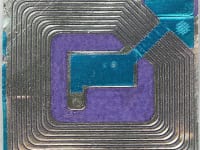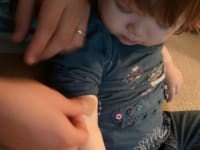During the course of an illness it is important to monitor the vital signs of a patient to track their progress. In most clinical situations this information can be gathered by doctors or nurses, but there are a variety of electronic monitoring devices to aid in this task. Many, if not most, of these devices rely on wired sensors to detect electrical rhythms in the body, pulse, temperature, and other metrics. While these devices offer invaluable aid, they are subject to some limitations. When a patient is connected to these machines their mobility is limited, and in some cases the sensors themselves are bulky or uncomfortable.
This invention combines the use of short-to-medium range passive or battery assisted compact RFID sensors to take real-time biometric readings of temperature, respiration, etc. This technology is suitable for virtually any patient, but in particular it is intended for children and infants - largely because wired sensors offer a potentially fatal entanglement risk. By combining a stationary receiver with disposable or semi-disposable sensors, vital data can be collected without this risk. Simple sensors could be completely disposable (or recyclable) and come prepackaged in adhesive bandages. More complex and costly sensors could be manufactured in sealed casings such that they could be held in place by bandages and subsequently be sterilized and reused. The use of RFID sensors may even be adaptable to current portable sensor technology, such as 24 hour EKG recorders. By removing the wires connecting the sensors to the recorder the device would be made much more comfortable.
More generally, in a hospital setting a series of receivers can be set up to monitor the patient virtually anywhere within the hospital grounds. If appropriate RFID tags are used this system can do double duty as a means to track patients or broadcast their location if they are under distress. In a domestic setting, a portable receiver can be set up on a bedside table or near a crib, and a battery-powered monitor can be carried throughout the house. If temperature or respiration moves beyond preset limits an alarm is sounded. The device could be integrated with a conventional baby monitor, and additionally the receiver could be built with a triangulation circuit to detect the child's movement within the sensing envelope. A combination of feedback from these sensors could be used to determine if the child is in distress and to sound an alarm.
Like this entry?
-
About the Entrant
- Name:Paul Connor
- Type of entry:individual
- Patent status:none





